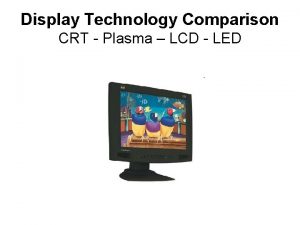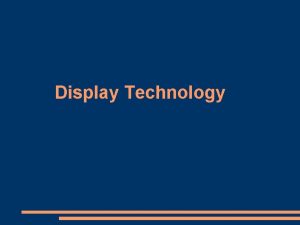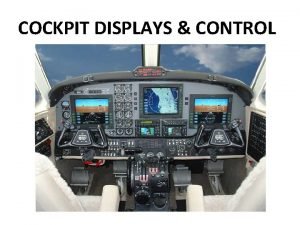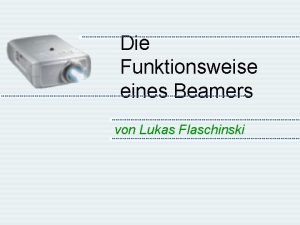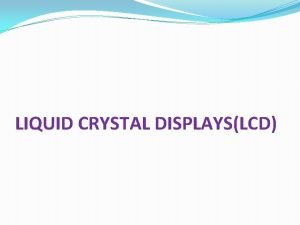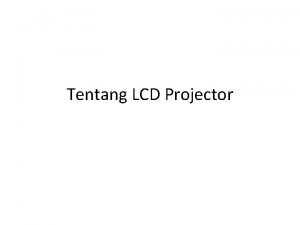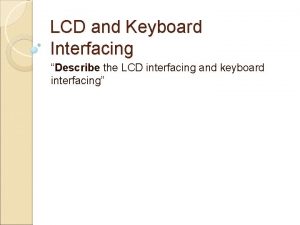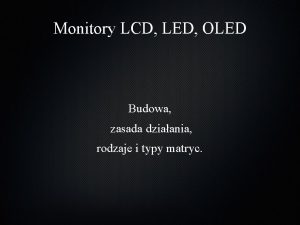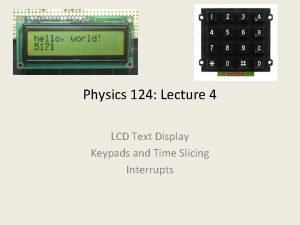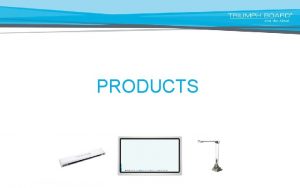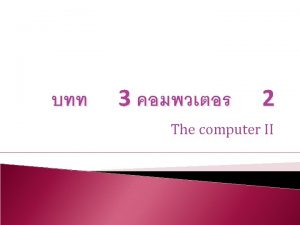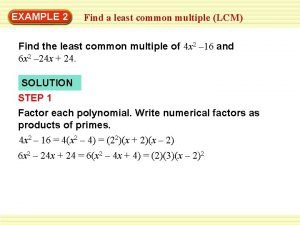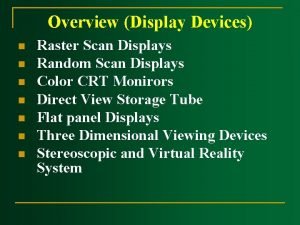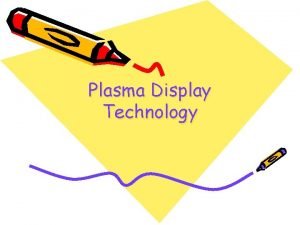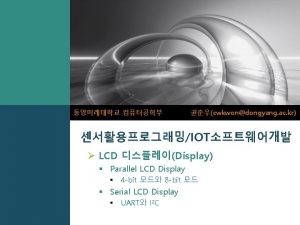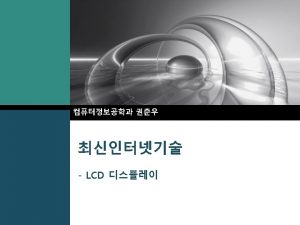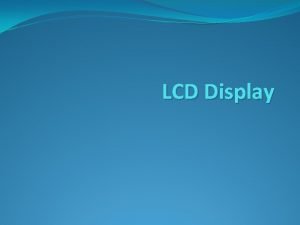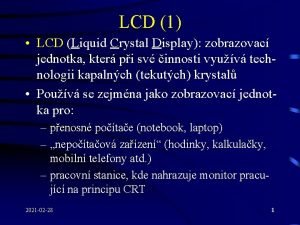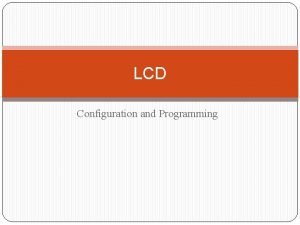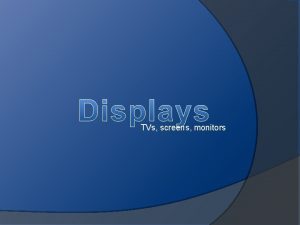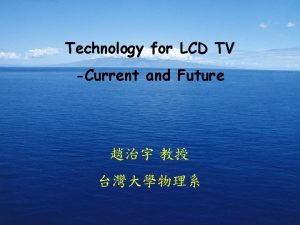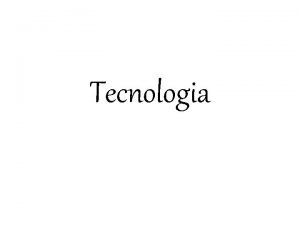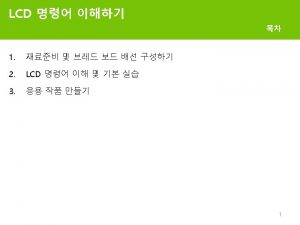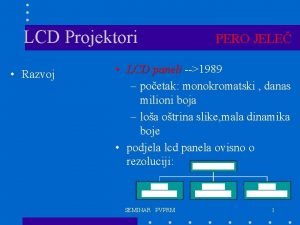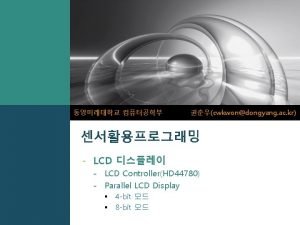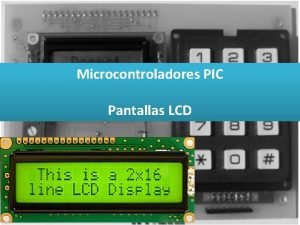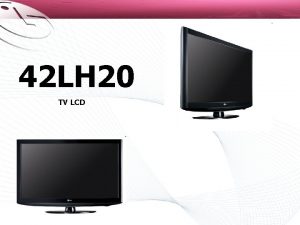Display Technology Display Technologies The Technologies CRT LCD



![CRT (Cathode Ray Tube) [cont. ] – As there’s only one electron gun, and CRT (Cathode Ray Tube) [cont. ] – As there’s only one electron gun, and](https://slidetodoc.com/presentation_image_h2/61fdea871eae6f6018ed49736505c3c2/image-4.jpg)

![CRT (Cathode Ray Tube) [cont. ] ● CRT Types – FST (Flat square tube) CRT (Cathode Ray Tube) [cont. ] ● CRT Types – FST (Flat square tube)](https://slidetodoc.com/presentation_image_h2/61fdea871eae6f6018ed49736505c3c2/image-6.jpg)
![CRT (Cathode Ray Tube) [cont. ] ● CRT Types (cont. ) – Chroma. Clear CRT (Cathode Ray Tube) [cont. ] ● CRT Types (cont. ) – Chroma. Clear](https://slidetodoc.com/presentation_image_h2/61fdea871eae6f6018ed49736505c3c2/image-7.jpg)
![CRT (Cathode Ray Tube) [cont. ] ● Advantages of CRT – – ● robust, CRT (Cathode Ray Tube) [cont. ] ● Advantages of CRT – – ● robust,](https://slidetodoc.com/presentation_image_h2/61fdea871eae6f6018ed49736505c3c2/image-8.jpg)

![LCD (Liquid Crystal Display) [cont. ] – – When a current is applied to LCD (Liquid Crystal Display) [cont. ] – – When a current is applied to](https://slidetodoc.com/presentation_image_h2/61fdea871eae6f6018ed49736505c3c2/image-10.jpg)

![LCD (Liquid Crystal Display) [cont. ] ● LCD Types – – Basically, there a LCD (Liquid Crystal Display) [cont. ] ● LCD Types – – Basically, there a](https://slidetodoc.com/presentation_image_h2/61fdea871eae6f6018ed49736505c3c2/image-12.jpg)
![LCD (Liquid Crystal Display) [cont. ] ● ● ● As these strips are relatively LCD (Liquid Crystal Display) [cont. ] ● ● ● As these strips are relatively](https://slidetodoc.com/presentation_image_h2/61fdea871eae6f6018ed49736505c3c2/image-13.jpg)
![LCD (Liquid Crystal Display) [cont. ] ● LCD Types [cont. ] – Active Matrix LCD (Liquid Crystal Display) [cont. ] ● LCD Types [cont. ] – Active Matrix](https://slidetodoc.com/presentation_image_h2/61fdea871eae6f6018ed49736505c3c2/image-14.jpg)
![LCD (Liquid Crystal Display) [cont. ] ● Advantages – – – ● Much smaller LCD (Liquid Crystal Display) [cont. ] ● Advantages – – – ● Much smaller](https://slidetodoc.com/presentation_image_h2/61fdea871eae6f6018ed49736505c3c2/image-15.jpg)
















- Slides: 31

Display Technology

Display Technologies ● The Technologies – – CRT LCD ● ● – PDP ● ● – – Dual Scan Active Matrix ALi. S PALCD Thin. CRT LEP

CRT (Cathode Ray Tube) ● 100 year old technology – A glass bell envelope contains a vacuum and an electron gun. By the application of a current, and electron stream is created, which is fired through the vacuum towards the inside face of the glass envelope. Here it strikes a phosphor layer, which converts the beam into visible light, colour being achieved through mixing varying levels of light intensity from red, green and blue phosphors.
![CRT Cathode Ray Tube cont As theres only one electron gun and CRT (Cathode Ray Tube) [cont. ] – As there’s only one electron gun, and](https://slidetodoc.com/presentation_image_h2/61fdea871eae6f6018ed49736505c3c2/image-4.jpg)
CRT (Cathode Ray Tube) [cont. ] – As there’s only one electron gun, and one beam for each colour, the screen needs to be refreshed constantly. This is achieved by altering the angle of the beam with a magnetic deflector coil, which deflects the beam across each part of the screen from top left to bottom right in a movement known as a raster. If refresh rate is set at 75 Hz and resolution is 1024 x 768 (XGA), this equates to painting 58, 982, 400 pixels per second.

![CRT Cathode Ray Tube cont CRT Types FST Flat square tube CRT (Cathode Ray Tube) [cont. ] ● CRT Types – FST (Flat square tube)](https://slidetodoc.com/presentation_image_h2/61fdea871eae6f6018ed49736505c3c2/image-6.jpg)
CRT (Cathode Ray Tube) [cont. ] ● CRT Types – FST (Flat square tube) ● ● – much less curvature than standard CRT uses shadow mask (smaller than screen size) to prevent distortion and overspill of electron stream Trinitron (also Diamondtron) ● ● to avoid light reduction caused by shadow mask, uses an aperture grille, a series of narrow alloy strips. grille improves light emission, but can move and is visible in background
![CRT Cathode Ray Tube cont CRT Types cont Chroma Clear CRT (Cathode Ray Tube) [cont. ] ● CRT Types (cont. ) – Chroma. Clear](https://slidetodoc.com/presentation_image_h2/61fdea871eae6f6018ed49736505c3c2/image-7.jpg)
CRT (Cathode Ray Tube) [cont. ] ● CRT Types (cont. ) – Chroma. Clear ● – Developed by NEC to combine shadow mask and aperture grille technologies. Uses vertically aligned slots in shadow mask focusing onto rectilinear phosphors. EDP (Enhanced Dot Pitch) ● Developed by Hitachi, focuses on the phosphor implementation. Rather than the standard equilateral triangle model, reduces distance between dots on the horizontal to create isosceles triangles of oval rather than round dots, giving a greater density of dots and hence better resolution.
![CRT Cathode Ray Tube cont Advantages of CRT robust CRT (Cathode Ray Tube) [cont. ] ● Advantages of CRT – – ● robust,](https://slidetodoc.com/presentation_image_h2/61fdea871eae6f6018ed49736505c3c2/image-8.jpg)
CRT (Cathode Ray Tube) [cont. ] ● Advantages of CRT – – ● robust, well-known technology high-quality resolution and image control Disadvantages of CRT – size (footprint) on monitors ● – short or mini-neck tubes possible, but exacerbates distortion problems analogue technology

LCD (Liquid Crystal Display) ● Work by polarisation of light – – Liquid crystals don’t emit their own light, but depend on a cold cathode backlight being passed through a sandwich of glass, liquid crystal and polarising filters, at right angles to each other. The liquid crystal molecules need to be aligned to allow the light to refract along the chain and out the other side. By anchoring the long crystal molecules to each side of the screen by grooves in the glass, their natural state creates the necessary alignment.
![LCD Liquid Crystal Display cont When a current is applied to LCD (Liquid Crystal Display) [cont. ] – – When a current is applied to](https://slidetodoc.com/presentation_image_h2/61fdea871eae6f6018ed49736505c3c2/image-10.jpg)
LCD (Liquid Crystal Display) [cont. ] – – When a current is applied to any screen element, the molecules lose the necessary alignment, so any light is blocked by the opposing polariser. Colour is produced in similar way to CRTs, with individual liquid crystal cells for red, green and Blue. Unlike phosphors, which emit light, the liquid crystals filter the light, allowing only their corresponding colours through.

![LCD Liquid Crystal Display cont LCD Types Basically there a LCD (Liquid Crystal Display) [cont. ] ● LCD Types – – Basically, there a](https://slidetodoc.com/presentation_image_h2/61fdea871eae6f6018ed49736505c3c2/image-12.jpg)
LCD (Liquid Crystal Display) [cont. ] ● LCD Types – – Basically, there a re two types of LCD technology that have become successful over earlier, less efficient techniques, passive and active matrix. Dual Scan (passive matrix) ● ● the matrix refers to the underlying layer of conductors, used to activate the screen elements. In passive matrix, this is usually made up of a lattice of conductive strips running from edge to edge of the display
![LCD Liquid Crystal Display cont As these strips are relatively LCD (Liquid Crystal Display) [cont. ] ● ● ● As these strips are relatively](https://slidetodoc.com/presentation_image_h2/61fdea871eae6f6018ed49736505c3c2/image-13.jpg)
LCD (Liquid Crystal Display) [cont. ] ● ● ● As these strips are relatively long, the time taken to activate each element is longer than in active matrix models. This means that it takes longer to refresh the screen, an effect that increases with the size of the screen and leads to submarining and the need to use mouse trails To improve the performance of passive matrix, dual scan LCD splits the conductor matrix into two sections, each of which are addressed separately by drivers down both sides of the screen. Dual scan maintains the low power requirement of passive matrix but increases refresh rate, with the result that many contemporary notebook displays use this technology
![LCD Liquid Crystal Display cont LCD Types cont Active Matrix LCD (Liquid Crystal Display) [cont. ] ● LCD Types [cont. ] – Active Matrix](https://slidetodoc.com/presentation_image_h2/61fdea871eae6f6018ed49736505c3c2/image-14.jpg)
LCD (Liquid Crystal Display) [cont. ] ● LCD Types [cont. ] – Active Matrix - TFT (Thin Film Transistor) ● ● uses a much more complex conductor array, replacing the lattice with a grid of independent transistors that lie on a layer beneath the screen elements. Far more complex to manufacture, but much faster because it independently addresses the liquid crystal cells. Viewing angle is wider, as transistor position obstructs backlight less than conductor strips. Much more expensive and has a higher power drain.
![LCD Liquid Crystal Display cont Advantages Much smaller LCD (Liquid Crystal Display) [cont. ] ● Advantages – – – ● Much smaller](https://slidetodoc.com/presentation_image_h2/61fdea871eae6f6018ed49736505c3c2/image-15.jpg)
LCD (Liquid Crystal Display) [cont. ] ● Advantages – – – ● Much smaller footprint than CRT Lighter, so appropriate for portables Digital technology (analogue connectors - new DVI) Disadvantages – – More expensive than CRT (but less so now!) Poorer resolution ● both types based on 100 dpi, but IBM Monet now gives 150 dpi and IBM Roentgen will give 200 dpi

Plasma Display Panels ● PDP – – Plasma Display Panels Based on the principle that certain gases emit light when subject to an electric current John Logie Baird first considered this technology as a possibility for producing an image on a screen Original plasma screens were monochrome, low resolution and very power hungry. They worked by capturing neon gas between two plates that were etched with conductive lines.

PDPs – – The conductive lines are at right angles to one another (similar to LCD) and as current is passed along selected lines, or channels, the gas in between glows and the image is built up. Modern PDPs contain a cocktail of gases that emit ultraviolet, rather than visible, light, which is then used to excite a phosphor layer, in a similar way to the electron stream in CRTs. This gives far greater accuracy in the resultant image while retaining the brightness and speed of the original principle.

PDPs – Using this current technology, PDPs can’t be made to rival the resolution of LCD, so they haven’t been used for monitors and notebook displays. However, they can be made to a considerable size and their natural brightness makes them highly suitable for large advertising displays, such as noticeboards at airports and train stations or product information screens at trade-shows and exhibitions.

PDPs ● ALi. S – – Fujitsu is developing a new plasma display type that will overcome the low resolution restrictions of current PDPs Alternate Lighting of Surfaces uses interlaced rather than progressive scans to increase the resolution of screens. This is achieved by creating a sandwich of two layers of the plasma display and removing the conducting lines that separated the channels.

PDPs – – The result is that, as well as offering a higher level of resolution, the displays are even brighter and it actually only uses around half the drivers of the older technology. Ali. S has been developed to compete in the digital television market, where a resolution of around 960 lines on screen is demanded.

PDPs ● PALCD – – – A hybrid of PDP and LCD, the Plasma Addressed Liquid Crystal Display. Sony and Tektronix are currently working on making a viable commercial PALCD. Rather than use the ionisation effect of the contained gas for the production of an image, PALCD replaces the active matrix design of TFT LCDs with a grid of anodes and cathodes that use the plasma discharge to activate LCD screen elements

PDPs – – With the exception of the plasma activation, the rest of the display uses standard LCD components. PALCD displays can be built to provide 42” (105 cm) and greater presentation displays and televisions, the resolution achievable being good enough to support digital television though they won’t be used for monitors. A significant advantage of PALCD is the lack of semiconductor controls. This means that the displays can be built in low-grade clean rooms, reducing costs. Claimed to be brighter, and still thin.

New Technologies ● Thin. CRT – – Developed by Candescent, who have replaced the electron guns, deflection yoke and shadow mask of the standard CRT with a perforated conductive sheet through which conical cold cathode emitters, known as Spindt Cathodes, protrude. Passing a current through the conductive sheet causes the cathodes to emit a stream of electrons, which cause phosphor elements to glow in exactly the same way as a standard CRT.

Thin. CRT – ● Spindt Cathodes are very small, only 200 nanometres each, so it takes several of them to activate individual pixels onscreen. This allows a relatively high failure rate, Candescent claims 20%, before any degradation of the image is visible. As a result this technology is more viable for mass production than LCD. Advantages of Thin. CRT – Thin, a fraction of the depth of CRT, so more like LCD and PDP

Thin. CRT – – ● Offers the same, or better, quality of resolution as CRT, so better than LCD and PDP. Brighter, wider viewing angles, lower power consumption. Potential Disadvantage of Thin. CRT – In order to function, the cathodes still need to reside in a vacuum. In order to stop the glass envelope from collapsing, Candescent has developed a non-conductive ceramic compound which is made into 0. 05 mm spacers to keep the sides apart. They shouldn’t interfere with the image but how robust they are is currently an unknown factor.

LEP ● LEP – – – Light Emitting Polymers Conjugated polymers, such as polyprolle [which has been known for over 100 years] and polyaniline, are plastic materials with physical properties that confer conductive properties. In recent times these polymers have been used for battery electrodes, transparent conductive coatings, capacitor electrolytes and circuit-board plating.

LEP – – When Cambridge University discovered that certain conjugated polymers, specifically pphenlylenevinylene (PPV), could be made to emit light in addition to carrying current, the idea of using LEP for displays was born. Cambridge Display Technologies have been developing this technology, working on the display technology itself, and the creation of stable red, green and blue polymers based on PPV.


LEP – Essentially the creation of the display itself is similar to, but simpler than, LCD. On the surface of a layer of substrate a transparent electrode layer is applied, on top of which a PPV layer is applied, and then a second electrode layer. When current is passed between the two electrode layers the polymer will emit photons, which pass through the transparent electrode layer and the substrate to the viewer. The display is structured into cells, similar to the picture elements of an LCD, and each cell can be addressed individually using an active matrix of electrodes.

LEP – ● LEPs are about to hit the market, probably initially as backlight surfaces for handheld PCs and information displays, in the market currently served by monochrome LCDs, but they could have a major impact in the future. Adavantages of LEP – – Can be applied to very large surfaces, so far greater than the current 42” PDP maximum. Polymer can flex with the base surface

LEP – – ● Potential Disadvantage of LEP – ● Far cheaper to make than competing technologies, substrate doesn’t require to be glass, simple electrode structure, easy to produce. Lightweight Longevity and efficiency of LEP still unknown factor Philips has created a dedicated fabrication plant!
 Monitor crt budowa
Monitor crt budowa Plasma vs crt
Plasma vs crt Crt display technology
Crt display technology Display
Display Raster scan display and vector scan display
Raster scan display and vector scan display Difference between random scan and raster scan
Difference between random scan and raster scan Random and raster scan display
Random and raster scan display Funktionsweise beamer
Funktionsweise beamer Tft roadmap
Tft roadmap Lcd of 11/8 and 7/20
Lcd of 11/8 and 7/20 Dynamic scattering type lcd
Dynamic scattering type lcd Clay tablets pre industrial age
Clay tablets pre industrial age Ukuran screen projector
Ukuran screen projector How to find a least common denominator
How to find a least common denominator Afficheur lcd capteur ou actionneur
Afficheur lcd capteur ou actionneur Lcd rs
Lcd rs Avr simulator
Avr simulator Lcd and keyboard interfacing
Lcd and keyboard interfacing Shawn lupoli
Shawn lupoli Fast score hospice
Fast score hospice Zasada działania monitora lcd
Zasada działania monitora lcd Lcd physics
Lcd physics Interactive touch screen presentation software
Interactive touch screen presentation software Bit mapped display
Bit mapped display Lcm of 3 and 4
Lcm of 3 and 4 Graphics hardware in computer graphics ppt
Graphics hardware in computer graphics ppt Fu associates ltd
Fu associates ltd Telewizor lampowy wikipedia
Telewizor lampowy wikipedia Lcd
Lcd Screenless display technology ppt
Screenless display technology ppt Display technology in computer graphics
Display technology in computer graphics Plasma display technology
Plasma display technology

